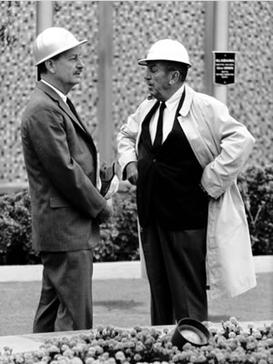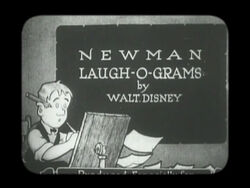
Walter Elias Disney was an American animator, film producer, voice actor, and entrepreneur. A pioneer of the American animation industry, he introduced several developments in the production of cartoons. As a film producer, he holds the record for most Academy Awards earned and nominations by an individual. He was presented with two Golden Globe Special Achievement Awards and an Emmy Award, among other honors. Several of his films are included in the National Film Registry by the Library of Congress and have also been named as some of the greatest films ever by the American Film Institute.

The Walt Disney Company is an American multinational mass media and entertainment conglomerate headquartered at the Walt Disney Studios in Burbank, California. Disney was founded on October 16, 1923, by brothers Walt Disney and Roy Oliver Disney as Disney Brothers Cartoon Studio; it also operated under the names Walt Disney Studio and Walt Disney Productions before changing to its current name in 1986. In 1928, Disney established itself as a leader in the animation industry with the short film Steamboat Willie. The film used synchronized sound to become the first post-produced sound cartoon, and popularized Mickey Mouse, who became Disney's mascot and corporate icon.

John Hench was an American artist, designer and director at The Walt Disney Company. For 65 years, he helped design and develop various Disney attractions and theme parks.

Brian David Sibley is an English writer. He is author of over 100 hours of radio drama and has written and presented hundreds of radio documentaries, features and weekly programmes. Among his adaptations is the 1981 version of The Lord of the Rings for radio. A columnist and author, he is widely known as the author of many film "making of" books, including those for the Harry Potter series, and The Lord of the Rings and The Hobbit trilogies.

Disney's Hollywood Studios is a theme park at the Walt Disney World Resort in Bay Lake, Florida, near Orlando. It is owned and operated by The Walt Disney Company through its Experiences division. Based on a concept by Marty Sklar, Randy Bright, and Michael Eisner, the park opened on May 1, 1989, as the Disney–MGM Studios Theme Park, and was the third of four theme parks built at Walt Disney World. Spanning 135 acres (55 ha), the park is themed to an idealized version of Hollywood, California, and is dedicated to the imagined worlds from film, television, music, and theatre, drawing inspiration from the Golden Age of Hollywood.

The Laugh-O-Gram Studio was an animation studio located on the second floor of the McConahay Building at 1127 East 31st in Kansas City, Missouri, that operated from June 28, 1921, to October 16, 1923.

Robin Hood is a 1973 American animated musical adventure comedy film produced by Walt Disney Productions and released by Buena Vista Distribution. Produced and directed by Wolfgang Reitherman, it is based on the English folktale "Robin Hood". The story follows the adventures of Robin Hood, Little John, and the inhabitants of Nottingham as they fight against the excessive taxation of Prince John, and Robin Hood wins the hand of Maid Marian. The film features the voices of Brian Bedford, Phil Harris, Peter Ustinov, Pat Buttram, Monica Evans, Terry-Thomas, Roger Miller, and Carole Shelley.

Walt Disney Studios Park is the second of two theme parks built at Disneyland Paris in Marne-la-Vallée, France. which opened on 16 March 2002. It is owned and operated by The Walt Disney Company through its Experiences division. Upon opening, it was dedicated to show business, movie themes, production, and behind-the-scenes, but in the 2010s, in a similar manner to Disney's Hollywood Studios at Walt Disney World in Florida, it began to distance itself from the original studio backlot theming and entered a new direction of attraction development inspired by iconic Disney stories. The park is represented by the Earffel Tower, a water tower with Mickey Mouse ears similar to the one formerly located at Disney's Hollywood Studios, which in turn was inspired by the water tower at the Walt Disney Studios lot in Burbank, California.

Walt Disney Animation Studios (WDAS), sometimes shortened to Disney Animation, is an American animation studio that creates animated features and short films for The Walt Disney Company. The studio's current production logo features a scene from its first synchronized sound cartoon, Steamboat Willie (1928). Founded on October 16, 1923, by brothers Walt Disney and Roy O. Disney after the closure of Laugh-O-Gram Studio, it is the longest-running animation studio in the world. It is currently organized as a division of Walt Disney Studios and is headquartered at the Roy E. Disney Animation Building at the Walt Disney Studios lot in Burbank, California. Since its foundation, the studio has produced 62 feature films, from Snow White and the Seven Dwarfs (1937) to Wish (2023), and hundreds of short films.

Floyd E. Norman is an American animator, writer, and cartoonist. Over the course of his career, he has worked for various animation companies, among them Walt Disney Animation Studios, Hanna-Barbera Productions, Ruby-Spears, Film Roman and Pixar.

Toon Studio is a land at Walt Disney Studios Park in Disneyland Paris, France.

World of Color is a nighttime show at Disney California Adventure in the Disneyland Resort in Anaheim, California. Conceived by Vice President of Parades and Spectaculars Steve Davison, and designed by Disney Live Entertainment, the show has 1,200 water fountains and includes lights, fire, lasers, and fog, with high-definition projections on mist screens. The show is inspired by Walt Disney's Wonderful World of Color anthology television series, as evidenced by the use of its eponymous theme song written by the Sherman Brothers.
Art of Disney Animation is an attraction at the Disney California Adventure in Disneyland Resort and Hong Kong Disneyland in Hong Kong Disneyland Resort. In Walt Disney Studios Park, the attraction opened on March 16, 2002 in the Toon Studio area, but was closed on January 7, 2019. It was reopened on November 17, 2019.

D23: The Official Disney Fan Club, also known as Disney D23 or simply D23, is the official fan club for The Walt Disney Company. Founded in 2009, the organization is known mainly for its biennial exposition event, D23: The Ultimate Disney Fan Event. The name D23 refers to D for Disney and 23 for 1923, which is the year Walt Disney founded the company.

Main Street, U.S.A. is the first "themed land" inside the main entrance of the many theme parks operated or licensed by The Walt Disney Company around the world. Main Street, U.S.A. is themed to resemble American small towns during the early 20th Century. In Tokyo Disneyland, it is called World Bazaar and covered by a glass Victorian-style conservatory roof to shield guests from the weather there. At Shanghai Disneyland, it is called Mickey Avenue and is orientated to help introduce visitors to Disney characters.

Mickey's PhilharMagic is a 4D film attraction found at several Disney theme parks around the world, including Magic Kingdom theme park at the Walt Disney World Resort, Hong Kong Disneyland, Tokyo Disneyland, Disneyland Park (Paris), and Disney California Adventure. The film was directed by George Scribner, who also directed Disney's 1988 animated film Oliver & Company. Mickey's PhilharMagic is a 12-minute-long show featuring 3D effects, scents, and water, as well as a number of characters from Disney movies. It is shown on the largest purpose-built 3D screen ever made, at 150 feet wide.

Disney's Nine Old Men were a group of Walt Disney Productions' core animators, who worked at the studio from the 1920s to the 1980s. Some of the Nine Old Men also worked as directors, creating some of Disney's most popular animated movies from Snow White and the Seven Dwarfs to The Rescuers. The group was named by Walt Disney himself, and they worked in both short and feature films. Disney delegated more and more tasks to them in the animation department in the 1950s when their interests expanded, and diversified their scope. Eric Larson was the last to retire from Disney, after his role as animation consultant on The Great Mouse Detective in 1986. All nine members of the group were acknowledged as Disney Legends in 1989 and all would receive the Winsor McCay Award for their lifetime or career contributions to the art of animation.

Get a Horse! is a 2013 American animated comedy short film produced by Walt Disney Animation Studios and directed by Lauren MacMullan. Combining black-and-white hand-drawn animation and color computer animation, the short features the characters of the late 1920s Mickey Mouse cartoons.

Fantasia is an American media franchise owned by The Walt Disney Company that commenced in 1940 with the theatrical release of the film of the same name.


















